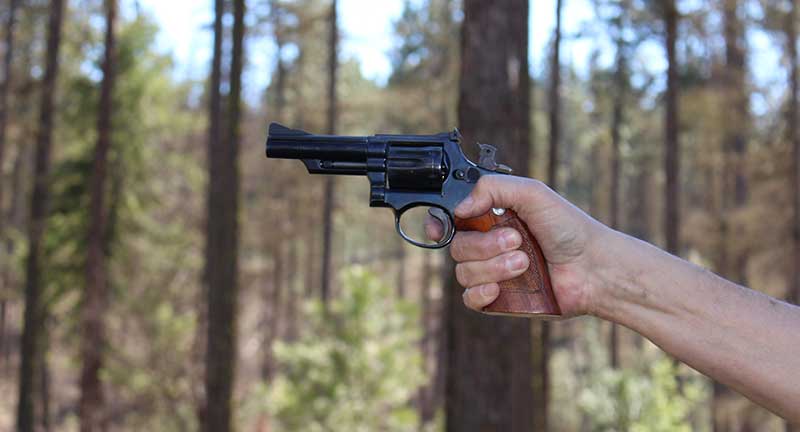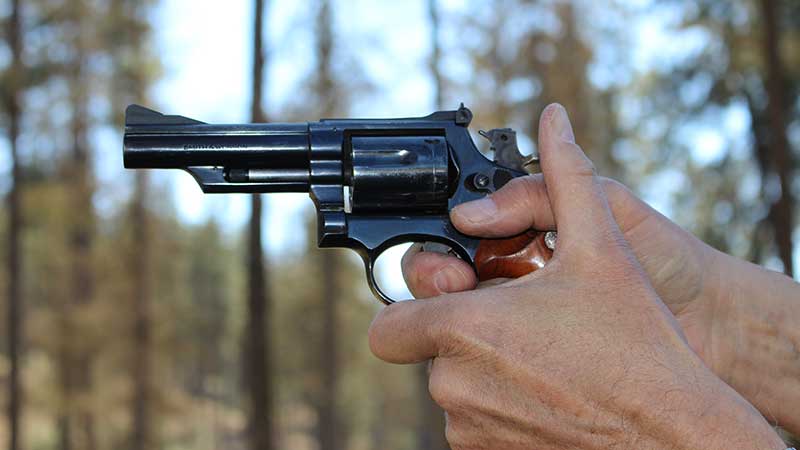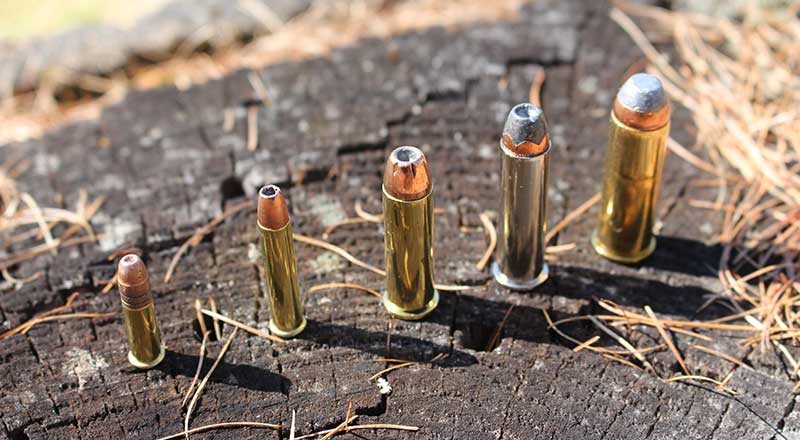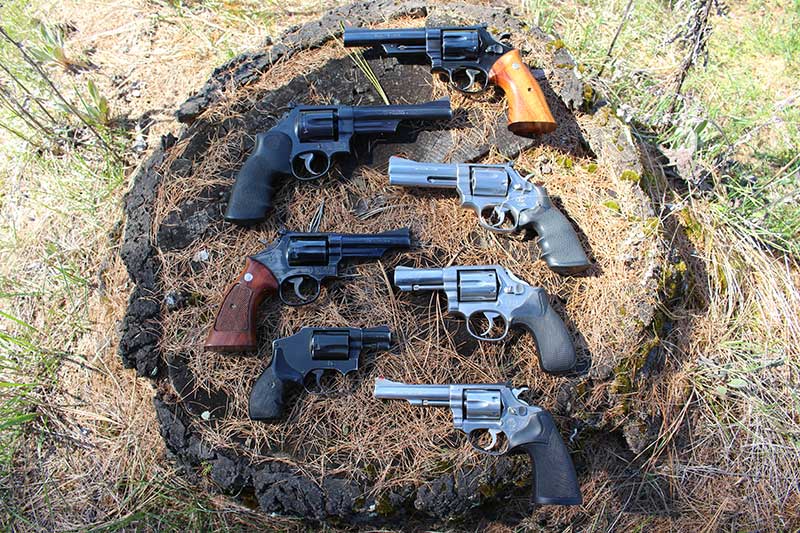
AC-112320-RunWheel-RW-6-800
In late 1972, I was hitchhiking home, on leave. Not many troops wore uniforms in public in those days, but I was in Class A’s, with spit-shined jump boots, ‘cuz dad was a retired Airborne Command Sergeant Major and asked me to.
As I passed a small gun store, The Force made me stop and go in. The owner had just put out three S&W “N” frame Model 29 .44 Magnum revolvers, which were really hard to get right after Dirty Harry. The short story is that since I was a soldier, he held it until I could wheedle a loan out of dad. The price was $425.00 (list was $273.00), which was close to two moths pay. Best money I ever spent, and I still have that gun.
I was teaching a handgun instructor course last year for a state POST. After the usual orientations and introductions, I asked how many of the officers had never carried or trained with, a revolver. It was an epiphany when I found that none of them had.
Like most former policemen of a certain “vintage”, I started with a revolver. My first duty gun was a six-inch S&W Model 28—the duty revolver for the Alaska State Troopers was a S&W Model 19, and later a model 686.
Each was a good gun, though the Model 19 “K” frame was too light a frame for a steady diet of magnum ammunition; the heavier 686, an “L” frame, stood up better. Over the years, I’ve owned many revolvers, from .22’s to a .454 Casull and a .500 Linebaugh. I even owned a Webley-Fosbury .455 Automatic Revolver.
The revolver became the king of personal defense in the 1840s. Colt came out with one of the first marketable, fairly reliable revolvers with the “Paterson” model. Colt got a huge shot in the arm when the Texas Rangers asked for a larger, heavier revolver for mounted warfare against Comanche’s and Mexican bandits—the Walker Colt.
The 1861-1865 difficulty between the Union and the Confederacy led to revolver development and use by a dozen different makers, some of which are still in business.
I’ve carried a revolver both on and off duty, and often carry one today. If I could only own one handgun it might well be that first .44 revolver. My friend and fellow martialist, Clint Smith, often carries a wheelgun as he cruises Thunder Ranch—lots of cougars there.
An advantage to revolvers is that they are not “black” guns; at the most, they hold nine rounds, usually five or six, so they are below the radar in most anti-gun locations.
Revolvers are usually divided into two action types: single-action (technically thumb cocking) and double-action (trigger cocking). I worked with a trooper in Alaska, a Texan, who carried a Colt Single Action Army in .44 Special when not in uniform. However, double-action revolvers have been the preferred defensive type since the late 1800s and I’ll focus primarily on them.
There are a couple of schools of thought on trigger cocking vs. thumb cocking. I tend to thumb cock when shooting a heavy load at distance, and trigger cock with lighter loads when using it defensively.
When trigger cocking, I place the trigger in the “power crease”, in the first joint of the trigger finger; when thumb cocking the trigger is on the pad of the finger. Some prefer to shoot in either mode by placing the pad on the trigger. I pull the trigger straight to the rear and avoid “staging”, which is partially cocking the gun by pulling the trigger, pausing, then finishing the press.
There are arguments for and against everything said above, but you’ll have to train and practice to see what works for you. I have two S&W revolvers with bobbed hammers, which precludes easily thumb cocking.
One advantage of revolvers is the variety of heavy cartridges available. I think of the .357 Magnum as a medium caliber, but last I heard it had more confirmed one-shot stops than any other pistol caliber.
In heavier calibers, revolvers go from .41 Magnum through .45 Colt and .44 Magnum into several .50 caliber cartridges. Both S&W and Rossi build revolvers that shoot both the .45 Colt and .410 shotgun shells. Revolvers also come in 9mm, .40 S&W, and .45 ACP for ease of logistics.
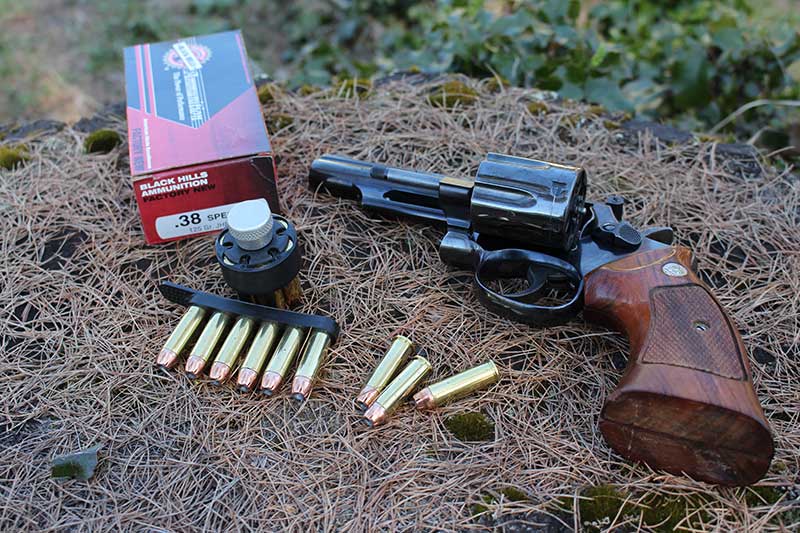
A good revolver, good ammo, speedloader and speedstrip—everything a well-trained shootist needs for “serious social interaction”.
Another plus to revolvers is reliability. Although rare, a stoppage with a revolver can result in a true jam rather than a malfunction that can be remedied with an immediate action drill.
One stoppage I’ve experienced is a high primer where the primer backs out of the primer pocket and binds against the recoil shield at the rear. The solution is to push the cylinder release latch and smack the hell out of the off-side of the cylinder, which allows it to open.
Another problem, usually with reloaded ammo, is a light crimp on the bullet. In this case the bullet may jump forward under recoil and not allow the cylinder to rotate. The only way to remedy it is to tap the offending bullet back into the case.
Finally, is a failure-to-fire: fix it by pressing the trigger again.
As a hunting handgun, a revolver is hard to beat. I habitually carried my .44 revolver any time I left the pavement in Alaska for protection against bears. In all truth, it’s pretty optimistic to believe than you can stop a charging brown bear with any handgun, but you can shoot your fishing buddy in the foot and run like hell while he distracts the bear.
I have killed bear, moose, caribou, deer and one goat with the Model 29, but almost always had a guy with a rifle backing me up.
As a defensive round, I have a lot of faith in the .44 Magnum. I responded to a shooting in a bar where the victim was hit in the hip with a single round—the damage was massive and death was immediate.
However, the .44 is really loud, has a lot of recoil, and recovery time between shots is fairly long, so it’s not the best choice as a primary defensive caliber. All of the calibers listed above are suitable for personal defense, along with the .38 Special and .357 Magnum, if the load is carefully selected.
The barrel length should be carefully considered in selecting a defensive revolver, and for a field gun. The magnum calibers need some time in the barrel to come up to full velocity, and one revolver guru I knows dismisses a two-inch .357 as “a really loud .38”.
Conversely, an 8 3/8-inch Model 29 might be a little difficult to carry and to draw quickly. I usually shoot Plus P .38 Special loads in my two-, three- and four-inch revolvers and .357 Magnums in five to six-inch guns.
As a good-all-around length, four inches will work. A two inch can work well, too—Jim Cirillo used one in many of his shootings as an NYPD detective.
My two favorite carry revolvers are a S&W Model 442, a hammerless .38 “J” frame, and a three-inch Model 65 “K” frame, loaded with Black Hills 100-grain Xtreme Defense .38 Special Plus P.
When out in the woods, I carry a 5 or 6.5-inch M 29 .44 Magnum, loaded with Black Hills 240-grain JHP’s. I generally stick to older pinned and recessed S&W’s. Pinned means a small pin through the frame into the barrel, recessed means the charge holes in the cylinder are chamfered, so the base of the case is flush with the cylinder.
One disadvantage to revolvers is that they take longer to reload—unless you’re Jerry Miculek. I can speed load a 1911 in about a second, two to three seconds for a revolver. The reality, though, is that most of us will never have to do a speed load in civilian life, other than in shooting matches.
The above-mentioned Det. Cirillo won a fight with two suspects while armed with a five-shot S&W M36 snubby—and he didn’t need to reload.
At one point, we went from 2.5 rounds fired (revolver days) per police shooting to 12.8 (high-cap auto-pistol days). Maybe coppers took a little more care aiming when you only had six tries to git ‘er done….
Revolvers are easy to TAC load, just like with an auto-pistol. With a revolver, once a shot or two is fired, open the cylinder and push the ejector rod slightly to the rear; the fired case(s) can be plucked out with thumb and index finger and a new round(s) can be loaded.
Rather than dumping a few rounds in your pocket, carry a QuickStrip from Tuff Products. This flat plastic strip holds five, six, or seven rounds and easily allows one or more rounds to be loaded when needed.
When all or most of the rounds in a conventional revolver have been shot, a speed load can be done with a speedloader—a plastic wheel that holds five or six rounds.
The two I am most familiar with are the HKS and the Safariland. Each works well, but differently. The HKS drops the rounds into the charge holes by turning a knob on the top; the Safariland uses a release in the center of the circle that releases the rounds when a knob contacts the extractor star.
In my experience, the HKS is more rugged, but the Safariland is faster. Get one of each for your revolver, try them, and then buy several for that particular gun. I carry one speedloader and one speed strip when I carry a revolver.
To speed load, push the cylinder release latch forward and open the cylinder by pushing on the off side; elevate the muzzle and punch the ejector rod, either with the thumb or by smacking it with the firing hand. All of the rounds/cases are ejected. Draw the speedloader, align the rounds with the charge holes, insert slightly, and release. Close the cylinder with the support hand and get back to work.
Some shooters prefer to use the strong hand for the speedloader, some the weak. I’m trying to convert to weak hand for economy of motion and not changing my grip with my strong hand.
One answer, other than lots of practice with speedloaders, is to carry a revolver that uses moon clips. These flat spring-steel clips hold two, three, six or more rounds, all of which go into the cylinder at once.
The design came about to allow .45 ACP rounds to be carried in military service revolvers, like the S&W and Colt Model 1917. S&W later built commercial guns like the 1955 Target, or Model 25, that used moon clips.
The really good news is that moon-clip revolvers are still being made, and there is one for most modern calibers.
I contacted S&W while at the SHOT show and arranged three test guns. I was able to get a 9mm, moon clip piece—the Model 929, and a Thunder Ranch special in .45 ACP.

To tac load, push the ejector slightly and pluck the spent casing out and reload from a SpeedStrip, loops are a pocket.
The Thunder Ranch .45 ACP revolver was everything you’d expect from a gun with Clint Smith’s name on it, as was the 9mm Jerry Miculek signature model, both from the S&W Performance Center. Both guns were very smooth, accurate, had nice triggers in either cocking mode, and were easy to shoot. The TR model even sports a light rail, which can come in handy on the farm or in the city.
The .45 Colt comes in a bunch of defensive loads, and a hot load approaches magnum energy. I fired some Winchester Defender PDX1 defensive rounds from this pistol, which was very manageable. I was able to put ten rounds into the head of an IPSC target at seven yards, both trigger-cocking and thumb-cocking the action. A well-constructed 225-grain bullet at 850 fps should discourage man or beast.
When properly trained and equipped, the revolver man is at no disadvantage in a pistol fight. I believe strongly that you aren’t a gun guy unless you can run and shoot a revolver. Each third-degree black belt (sandan) in my system has to come back and pass the first dan test with a revolver before he can continue.
Finding quality revolver training can be a little difficult. I went to a revolver class at Thunder Ranch several years ago, and it was outstanding. However, at most training schools there aren’t too many instructors who speak revolver, or who can show you how to keep it shooting.
The answer is to find an Old Guy, a retired policeman or FBI agent who still speaks wheelgun. Go to Thunder Ranch to train with Clint, or take a 250 Pistol class at Gunsite.
You’re not really a gun guy until you can shoot and run a revolver, since you may someday have to use one. Shop around and find a nice model 15, 19, 586, 686 or whatever appeals to you and try it out.
Seek out some quality training and add one more level to your defensive capabilities.
SMITH & WESSON
(800) 331-0852
www.smith-wesson.com
BLACK HILLS AMMUNITION
(605) 348-5150
www.black-hills.com
GUNSITE
(928) 636-4565
www.gunsite.com
THUNDER RANCH
(541) 947-5005
www.thunderranchinc.com
TUFF PRODUCTS
(877) 883-3776
www.tuffproducts.com

